The drive to Abydos is long. But if you are at all interested in pharaonic art, architecture and mythology a day trip to Abydos and Dendera is worth the effort. The Temple of Seti I in Abydos and the Temple of Hathor in Dendera are two of the most beautiful and best preserved in Egypt.
The most interesting aspect of Egypt, for me, is the abundance of fantastic myths and stories and its mind boggling array of gods almost rivalling those in our Hindu pantheon.
And the most intriguing of them is the myth of Osiris and Isis.
The story of the murder, dismemberment and subsequent resurrection of Osiris (long enough for sister/wife Isis, in the form of a kite, to conceive a child: the Falcon headed deity Horus) is fascinating even if improbable.
Just as fascinating is the story of the djed pillar intrinsic to the same story. When the coffin containing Osiris runs aground in Byblos (Syria), there sprouts a sacred tree that is cut and used as a pillar by the local king.
Isis eventually locates it and releases and anoints the body of Osiris from the coffin trapped within. The resurrected Osiris earns himself the title: Lord of the Dead and the Afterlife. That’s one of the reasons he is depicted with dark green skin.
That tree which grew around the mortal remains of Osiris is considered his symbolic backbone and signifies stability. The ceremony of Raising the Djed – represented by a wooden pillar that resembles a cross – then becomes a symbol of the triumph of good (Osiris) over evil (murderous brother Set). Inscriptions abound of the pharaoh raising the djed pillar with the blessings of priests and benevolent gods.
ABYDOS AND THE OSIRIS MYTH
It was believed that Isis, in the course of her hunt for the body parts of Osiris after Set chops him up into several pieces (numbers vary with every telling), locates his head in Abydos. It was also believed that the hill of Umm el-Gaab in the vicinity, is the tomb of Osiris. Thus elevating Abydos to one of the most sacred centres of pilgrimage for well over a millennium as well as a place, quite like Varanasi, where the devout wished to die.
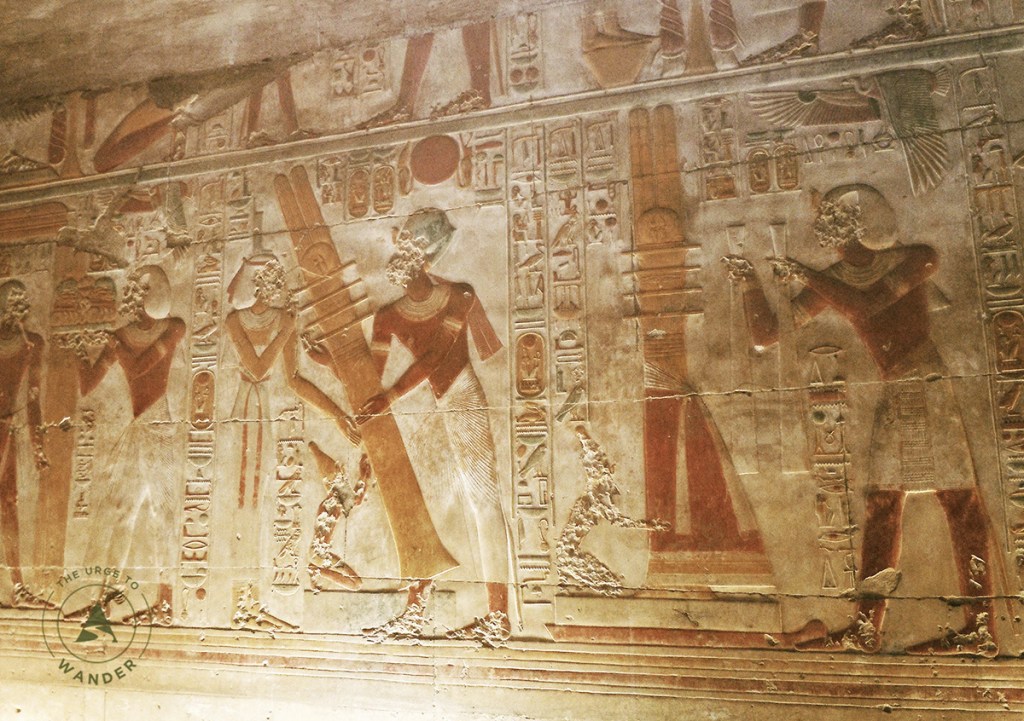
The Book of the Dead is said to contain a spell “to enter Abydos and become part of the retinue of Osiris”. So it became customary, for anyone who could afford it, to erect funerary temples, cenotaphs or stelae in this sacred town.
MEMORIAL TEMPLE OF SETI I IN ABYDOS
Of the many temples in the Abydos complex, the memorial temple of Seti I is the most important. Construction was started by Seti I himself (1318-1304 BC) and completed by his son Ramesses II.
The marked difference in the style and quality of reliefs undertaken by the two pharaohs is clear to see. Seti’s exceptionally beautiful raised bas reliefs are what UNESCO terms ‘classical purism’. Ramesses switched to sunken reliefs at some point, even converting some of the unfinished bas reliefs to sunken styles. They were quicker to execute and the prolific builder king had a great many monumental projects to complete elsewhere.
An unusual feature of the temple is the presence of seven chapels instead of the typical single sanctuary. The chapel of the great god Amun occupies the central space and is flanked by those of Osiris, Isis and Horus to one side and Ptah, Re-Harakhte and the deified pharaoh himself on the other. How do you tell the difference between Seti the pharaoh and Seti the deity? Look out for the looped Ankh in his hand, a symbol of divinity.

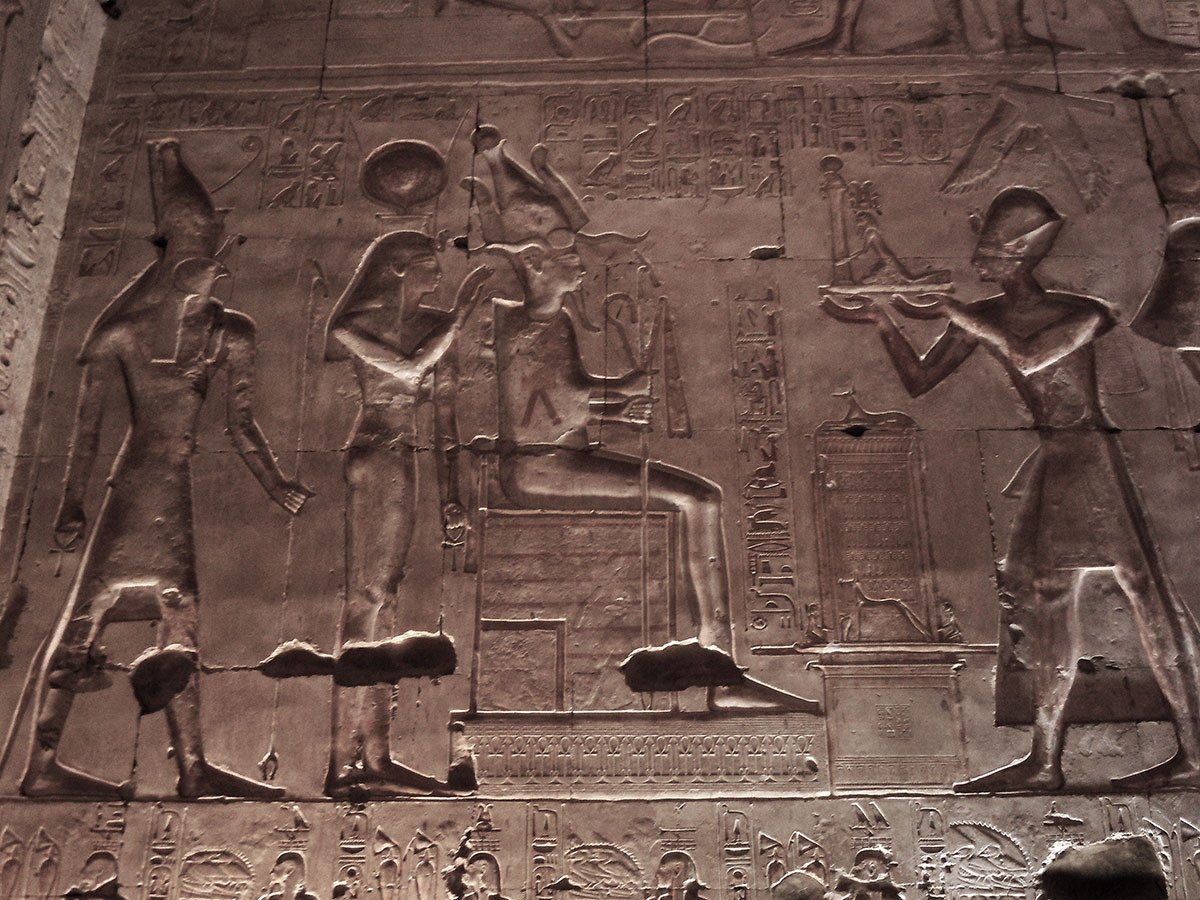

Many of the reliefs in the outer vestibules have been defaced by early Coptic Christians who used the temple for shelter. The art on the walls of the second hypostyle hall and some of the chapels are in better condition with exquisite reliefs – both raised and sunken and in vivid colour.
The walls of the Corridor of the Bull are covered with sunken reliefs of hunting scenes. My favourite is that of the pharaoh and his young son snaring a bull.
Along another long corridor beyond the second hypostyle hall is the Gallery of Kings with an entire wall covered with cartouches in relief: the famed ‘Abydos King List‘ of pharaohs from Menes of the first dynasty up until Ramesses I (father of Seti I) of the 19th. An incredible chronological record of nearly 1760 years from 3050BC to 1290BC.
Noted omissions, apart from a few minor kings, are the names of Hatshepsut, stepmother of Thutmose Ⅲ, Akhenaten the ‘heretic’ king whose introduction of monotheism to ancient Egypt backfired disastrously, and his three offspring – including Tutankhamen – who oversaw the end of the 18th dynasty. Tutankhamen’s military commander, Horemheb, usurped the throne from his brother Ay after the former’s mysterious death and eventually picked Ramesses I as his successor, thus ushering in the Ramesside Dynasty.

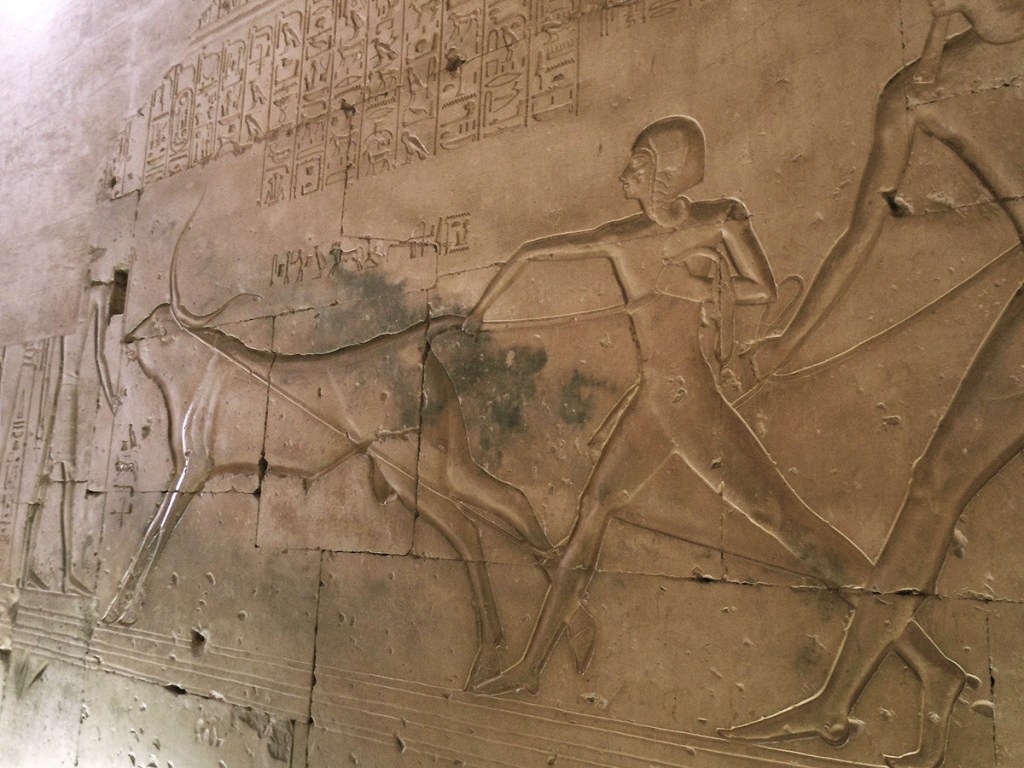
An arched passage leads out to a ruined sunken temple believed to be the Osireion connected with the worship of Osiris. That it was a place of pilgrimage from pre dynastic days is certified by the unearthing of offerings of ivory and gold including an ivory statue of Cheops (of the Great pyramid fame). The place is out of bounds for tourists and remains inundated most of the time.
The memorial temple of Ramesses II nearby seems to have fared even worse than his Ramesseum in Luxor. The few surviving reliefs are beautiful and might be worth a quick look if you have time to spare.
Abydos is not on the standard tourist radar and its spiritual ambience is undisturbed by noisy footfalls. The temple of Hathor in Dendera might well be more dramatic but its (relatively cruder) Ptolemaic reliefs are no match to the exquisite ancient Egyptian art of the Temple of Seti I.
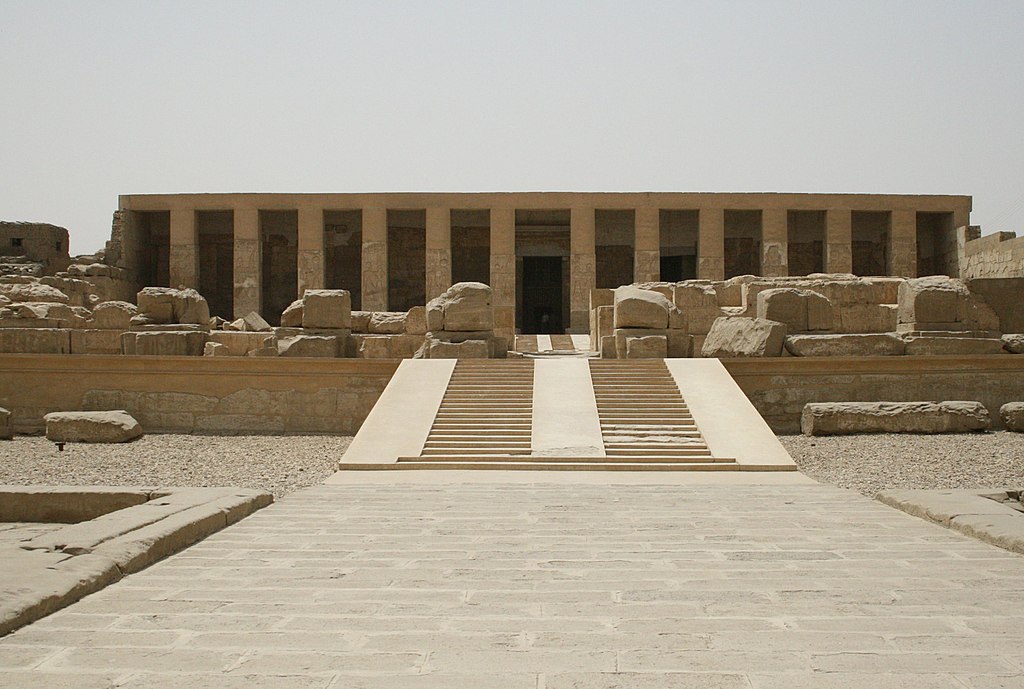

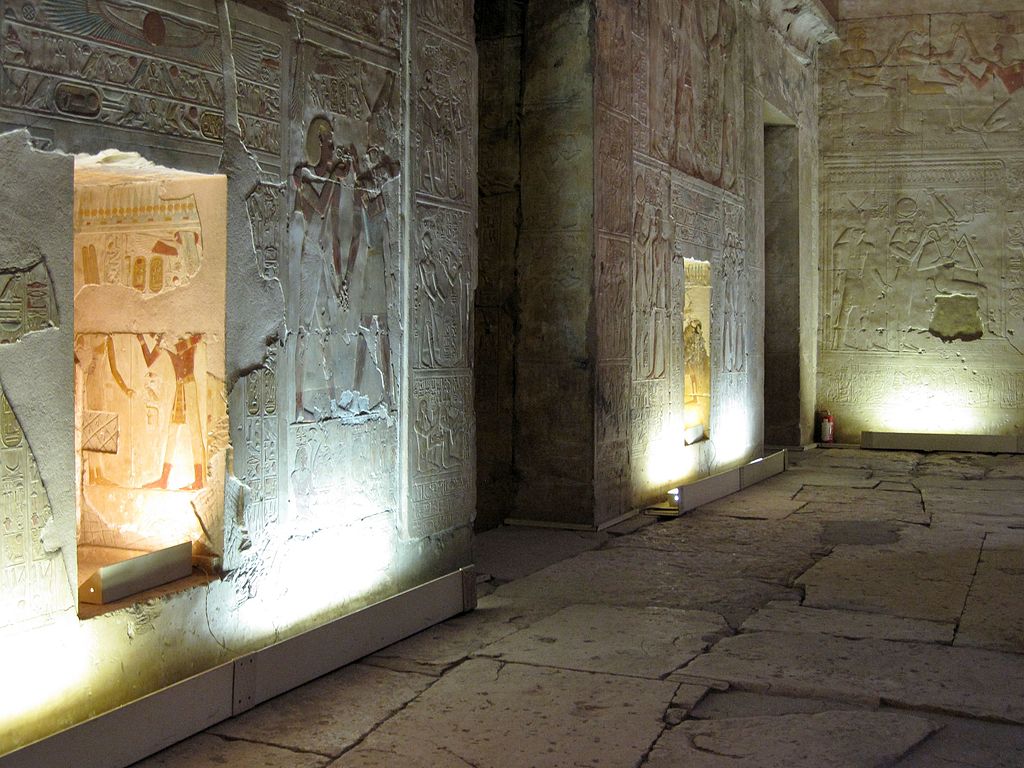
ABOUT THE DAY-TRIP TO ABYDOS & DENDERA
The 172 km drive from Luxor to Abydos takes about three hours.
We clubbed it with Dendera as a long day-trip, starting at the Seti I Temple since it is farther away and then returning via Dendera. Getting from Abydos to Dendera (105 km) takes about an hour and a half. Dendera to Luxor is about the same.
You’ll need nine to ten hours for the full day trip with about two hours in each temple complex. A half day trip to Denedera alone can be done in five hours.
GETTING TO ABYDOS: The best way to get here is by booking a car and driver through a travel company. Cost for up to two persons in a private car with guide is approximately US$ 130 excluding entrance fees as of this writing. Joining a tour is a slightly cheaper option.

JOIN OVER 20,000 TRAVEL ENTHUSIASTS AND RECEIVE A COMPLIMENTARY COPY OF THE TEN DAY EGYPT ITINERARY PACKED WITH BEAUTIFUL IMAGES AND ALL THE INFORMATION YOU’LL NEED TO PLAN YOUR TRIP
ABYDOS FAST FACTS
BEST TIME TO VISIT: Winter months between mid October to mid March.
HOURS: 08:00 – 17:00
ENTRANCE FEES (2019-20) : Adult: EGP 100/ Student: EGP 50
CAMERA FEE: EGP 300. Free with mobile phones.
WHERE TO EAT: You could carry packed lunch or get your driver to stop at a local restaurant on the way.
WHAT TO WEAR: Covering arms, shoulders and knees isn’t mandatory. My advice is to wear whatever you are comfortable in, but carry a light shirt or stole to throw over your shoulders when needed. I would avoid shorts everywhere. Khakis, loose cotton pants or skirts are ideal.
MORE INSPIRATION/TIPS FOR YOUR TRIP TO EGYPT
EGYPT TRAVEL GUIDE – ALL YOU NEED TO PLAN A PERFECT TRIP
EGYPT ITINERARY – AN EPIC TEN DAY JOURNEY
PYRAMIDS OF EGYPT – GIZA, SAQQARA & DAHSHUR
INTO THE HEART OF HISTORIC CAIRO
STAR GAZING IN DENDERA
NUBiAN LANDSCAPES – THINGS TO DO IN ASWAN
THE TWIN TEMPLES OF ABU SIMBEL
KHUFU’S SHIP – THE SOLAR BOAT MUSEUM
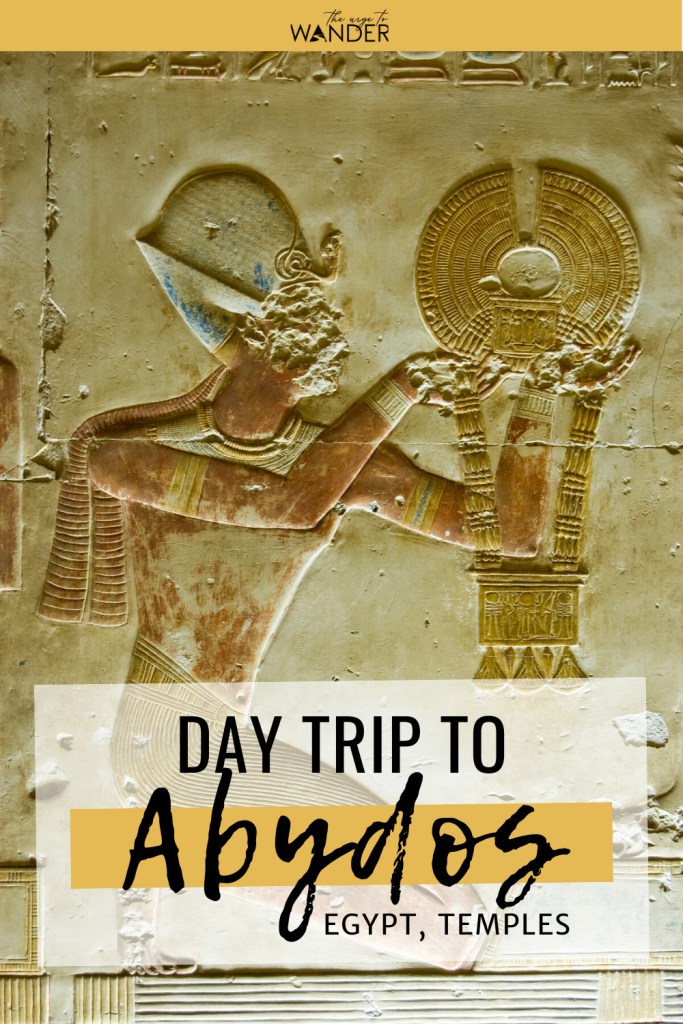
The study of ancient history and their belief systems is quite fascinating 🙂
Thanks for wanderfull narration. I had been to Abydos in May 2017.The bas reliefs are vivid with interesting storie
Really amazing–love the top photo!
Thank you for the grand tour, Madhu!
One of my favourites Amy, thank you for reading 🙂 Have you checked out the Dendera post? The ceiling there is breattaking! Even the one leftover after the French took the best bits to the Louvre!
Will check it out. Thank you!
Thanks again. The artwork, the stories are so impressive. I’ve been obsessed by the mathematics of the Great Pyramid for a while – as a thing of beauty. And surely the art and mythology is beautiful and comes from the same place. Thanks again.
Thank YOU for reading Bumbas!
Madhu, I agree with every comment above. These shots are amazing; I like how you use the light to bring out the images. Not only that, but your writing is superb…great voice. ~Mona
Really appreciate that Mona! Thank you very much!
Thank you for all the great information. I’ve always been a little intrigued by ancient Egypt, would love to visit someday.
Hope you do Jeff, Egypt is indeed fascinating!
I absolutely lost this post. The photos are stunning, otherworldly, the light just draws me into another world. As a storyteller, I have heard the myth of Isis and Osiris in many different versions, and you captured the essence of the story very well, but your retelling is the only one that made me laugh aloud. I can’t tell you how much I enjoy the balance stories and history with your artful and evocative photos.
THANK YOU Naomi! That is music to my ears 🙂
I’ve read in one of National Geographic Magazine’s editions which stated that Abydos is the oldest site of the ancient Egypt civilization (if I’m not mistaken). Never read any story about that particular place other than the one in the magazine. So your story definitely enriches my knowledge about Abydos. Keep writing great stories on Egypt! I love them!
Loads more stories there! The discovery of 14 solar boats – the worlds earliest solid plank boats – is one! Lots of antiquities were destroyed when the modern town was built right over existing temples! Thanks for the thumbs up Bama! Truly appreciate your feedback!
Egypt is a must see for me. I’ve been putting it off because I want to be able to spend plenty of time there. But I really want to go!
You should, you will love it!
I enjoyed every photo You presented here. Great series!
Appreciate that Sratenada! Thank YOU!
Wow That is Just Amazing
DarkJade-
Thank you for checking out my blog and the comments! Will have to make time to read your fantastic stories!
You’re Welcome, This is an Amazing Site
Stories are one thing, This is Something Else… Simply Amazing…
DarkJade-
Thank You 🙂
Stunning photo’s again! It always strikes me at how artistic the Egyptians were. I love this. Thanks for sharing. 🙂
You are welcome Sonel! Thanks for the comments!
Great story Madhu, and the pictures look awesome!
Glad you think so Marcia! Thanks you!
Beautiful! Thanks again for exposing me to so much history in a visual manner.
BE ENCOURAGED! BE BLESSED!
Thank you for joining the tour 🙂
beautiful images!!
Thanks Mimo 🙂
Fascinating stuff. Thank you for the photos and explanations.
It is! Thank YOU for reading!
Glorious! I have not been to Egypt but I’m captured by its myths and history. I’ve travelled to see some exhibitions of antiquities but nothing would beat a trip to the tombs themselves. Beautiful pics and commentary. Thanks for sharing!
Thanks Louise! These images are of the temples. The tombs in the Valleys of the Kings, Queens, Noble, Scribes are all underground and the frescoes inside are unbelievable – way superior to what you see here! Photography is strictly prohibited though!
Breathtaking in complexity, form and scale, considering the tools available at the time. Such wonderful pics. I went to Melbourne last year to see the Tutankhamun exhibition which was great but loved the antiquities from the Louvre the best. I am yet to see the Treasures in the British Museum but it is on the list. Not sure if I’ll ever get to Egypt itself though. Maybe. One day.
Love your blog posts on Egypt! We received so much information from our guide I couldn’t remember it all. It is one of the many reasons I plan to return yearly and bring a tour group with me! LOL
Lucky you! Abydos & Dendera were freely accessible when we went in 2010. They have apparently re-introduced the convoy system to Dendera after the uprising. Convoys to Abydos have been suspended.
We got to go to both, too!
Wonderful photos and history of mythology. What incredible stories.
Incredible even for me, surrounded as I have been with so many of our own mythological stories in India!
fabulous post and pictures are unbelievable.. well captured doesn’t sound good enough..;)
Thank you so much Cobbies!
I honestly don’t know how the archeologists knew who was who and what their names were from 5,500 years ago. I find that amazing in and, of itself. This is a very interesting post. Thanks for sharing and for posting all of those great photos. Job well done!. 🙂
Thank YOU for reading Orples! To answer your question, the discovery in 1799 of the “Rosetta Stone” a stele that had Ptolemy V’s decree in three scripts including Greek was the key to unlocking the language and secrets of Egypt! The “Roseta Stone” is on display in the British Museum.
I’ve heard of the Roseta Stone, but never realized it’s significance, so I appreciate your taking the time to mention it here, and also for the lesson in Egyptian history. We studied the pyramids and tombs when I was in college … back when the dinosaurs roamed the Earth (according to my youngest child), so I’ve forgotten a lot.
The history really is fascinating, so as always, thanks for sharing. 😉